 Macrovision, a company who sell content protection (DRM) system, have today released a report they commissioned into content copying.
Macrovision, a company who sell content protection (DRM) system, have today released a report they commissioned into content copying.
The findings? That ‘Casual Piracy’ is “a Growing Challenge in the Entertainment Industry” and that “mass market penetration of digital recording devices and broadband/file-sharing networks are prompting many entertainment brands to enrich their content protection strategies and influence bottom line performance.”
Let us translate. Digital Rights Management (DRM) is coming and the public had better start getting used to it.
 This is on the basis of what to us appears, from a quick once over of this report, a pretty unscientific approach, as the following paragraph from page 10 illustrates.
This is on the basis of what to us appears, from a quick once over of this report, a pretty unscientific approach, as the following paragraph from page 10 illustrates.
“In order to estimate exactly what effective content protection represents, respondents were also asked to estimate how many units/titles were copied (burnt) for each 100 sold and how many were illegally downloaded for every 100 sold.”
How can someone write “estimate exactly” without seeing the paradox? They just have well asked them “How paranoid are you about content copying?”
Their conclusion directly under this nonsense? “None of the figures make for comfortable reading.” WHAT?!?!? Just because these figures are presented in a table in a report with graphs next to them, doesn’t elevate them from what they are – guesses. At this point we stopped reading this report – we had some drying paint that needed watching.
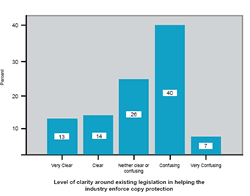 I hope that each time a ‘report’ or so called research like this is published, that it is gone through with a fine tooth comb pointing out its weaknesses. This kind of nonsense needs to be countered.
I hope that each time a ‘report’ or so called research like this is published, that it is gone through with a fine tooth comb pointing out its weaknesses. This kind of nonsense needs to be countered.
FUD rules
I have, for years, been questioning the content industry – How are you going to sell DRM to the public when what you’ll be selling them some less good/useful than they had before? The answer has always been a resounding silence.
When I asked a very senior person at Fox (his name escapes me) why DRM would be required when the vast majority of their customers are fair, reasonable and trustworthy, his response stunned me – “We take the opposite view, we treat everyone as dishonest.”
To me, that summed up both the arrogance and distain of the company, and possibly that of the current ‘entertainment’ industry. Any company that has such a low opinion of their customers, will eventually come to a sticky end – and it’s quite right that they do.
Through the sheer panic of suddenly waking up to the changes that technology has been bringing to media for decades (hell, I had digitised audio tracks on my Mac Plus, soon after it was released in 1984), the ‘entertainment;’ business has been listening to technology companies, who by strange co-incidence have something to sell – content protection systems.
That combined with the universal truth that fear is contagious, leads to a point where we are now. The current media companies being near terrified that _all_ of the customers are waiting to steal from them, so they must be restricted – and DRM-selling companies are more than happy to help them in their fear.
Their perceived need to restrict their customers is costing them _huge_ amounts of money and it will continue to … and to what gain?
They stop their customers from using their purchases how they feel fit – well, at least until the latest hack removes the protection – and in the process, further alienate their customers, building resentment.
Why don’t they spend all of this effort, time and money creating new content – engaging their audience further?
I wonder if the ‘entertainment’ companies have spared a thought as to what would happen if their businesses did fail? Do they not see that generally the technology companies are going to win anyway even without them?
PDF of complete report.
BTW, don’t try copying text out of the report, it’s protected unsurprisingly.
 Fujitsu Siemens have launched the “first handhelds with fully integrated GPS functionality”, the Pocket LOOX N500 and Pocket LOOX N520 PDAs.
Fujitsu Siemens have launched the “first handhelds with fully integrated GPS functionality”, the Pocket LOOX N500 and Pocket LOOX N520 PDAs.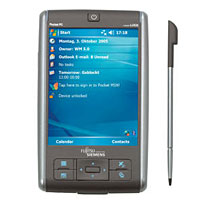 Powered by an Intel XScale PXA270 312 MHz CPU, the devices come with a SD/MMC slot (with support for SDIO), USB 1.1, IrDA and Bluetooth, with the Pocket LOOX N520 offering integrated wireless LAN 802.11g Wi-Fi.
Powered by an Intel XScale PXA270 312 MHz CPU, the devices come with a SD/MMC slot (with support for SDIO), USB 1.1, IrDA and Bluetooth, with the Pocket LOOX N520 offering integrated wireless LAN 802.11g Wi-Fi.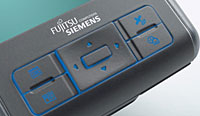 There’s also a ton of Fujitsu Siemens-branded applications bundled in the package, including Voice recorder, AudioPath and Key Look, along with a Microsoft Mobile suite including Excel, Power Point, Outlook and Internet Explorer.
There’s also a ton of Fujitsu Siemens-branded applications bundled in the package, including Voice recorder, AudioPath and Key Look, along with a Microsoft Mobile suite including Excel, Power Point, Outlook and Internet Explorer. A Hong Kong doleboy has been slapped down by The Man after he was found guilty of distributing three Hollywood films using BitTorrent’s peer-to-peer file sharing technology.
A Hong Kong doleboy has been slapped down by The Man after he was found guilty of distributing three Hollywood films using BitTorrent’s peer-to-peer file sharing technology. The OpenSource BitTorrent software has become one of the most popular means of downloading large files, with the technology allowing users to download fragments of a large file from multiple users, rather than in one hefty lump.
The OpenSource BitTorrent software has become one of the most popular means of downloading large files, with the technology allowing users to download fragments of a large file from multiple users, rather than in one hefty lump. The futuristic vision of a connected home with content moving seamlessly from our TV to our PC and on to our mobile device is still a long way off, according to key speakers at The Connected Home conference in London today.
The futuristic vision of a connected home with content moving seamlessly from our TV to our PC and on to our mobile device is still a long way off, according to key speakers at The Connected Home conference in London today. It took Dimitri Van Kets (pictured left), from Belgian telco, Belgacom, to voice what many were thinking by announcing that the networked home was “little more than a mass of standards” and “too confusing” for the average consumer. Unless the service providers get together and educate customers, he said, true home connectivity was never going to happen.
It took Dimitri Van Kets (pictured left), from Belgian telco, Belgacom, to voice what many were thinking by announcing that the networked home was “little more than a mass of standards” and “too confusing” for the average consumer. Unless the service providers get together and educate customers, he said, true home connectivity was never going to happen. Paul Szucs of Sony said that service providers should “try not to lose the plot with content protection”, adding that “consumers simply want their devices to work together and share content.”
Paul Szucs of Sony said that service providers should “try not to lose the plot with content protection”, adding that “consumers simply want their devices to work together and share content.” BT is planning to turbo-boost broadband connectivity by quadrupling basic connectivity speeds to 8mbps nationwide and giving the service a snappy name, “ADSL Broadband Max”.
BT is planning to turbo-boost broadband connectivity by quadrupling basic connectivity speeds to 8mbps nationwide and giving the service a snappy name, “ADSL Broadband Max”.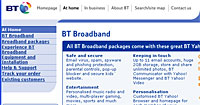 The 8mbps service will see BT reaching the theoretical top ADSL speeds it announced when the broadband service first launched in 2000.
The 8mbps service will see BT reaching the theoretical top ADSL speeds it announced when the broadband service first launched in 2000. With the industry rapidly consolidating, BT is coming under increasing pressure from newly merged uber-telecos like Telewest/NTL and Sky/Easynet, with the former already offering speeds of more than 8mbps for no extra charge on existing broadband subscriptions.
With the industry rapidly consolidating, BT is coming under increasing pressure from newly merged uber-telecos like Telewest/NTL and Sky/Easynet, with the former already offering speeds of more than 8mbps for no extra charge on existing broadband subscriptions. Elsewhere, BT has started trialling optical fibre broadband services in Wales, connecting business to ultra-high-bandwidth services using strands of blown fibre run along using existing telegraph poles.
Elsewhere, BT has started trialling optical fibre broadband services in Wales, connecting business to ultra-high-bandwidth services using strands of blown fibre run along using existing telegraph poles. Released today in Korea, the land where they get all the cool gadgets first, Samsung’s new SCH V700 handset has the honour of being the first PMP (Portable Media Player) phone in the world.
Released today in Korea, the land where they get all the cool gadgets first, Samsung’s new SCH V700 handset has the honour of being the first PMP (Portable Media Player) phone in the world.  The V700 comes in Samsung’s favoured clamshell design with the added twist of a tilting display which lets users rotate the screen 90 degrees to take advantage of a wider display (it looks a bit like ET to us in this position, but maybe we’ve been overdoing it a bit recently.)
The V700 comes in Samsung’s favoured clamshell design with the added twist of a tilting display which lets users rotate the screen 90 degrees to take advantage of a wider display (it looks a bit like ET to us in this position, but maybe we’ve been overdoing it a bit recently.) We’re impressed with the onboard TV out port which could prive a great way of sharing your photos with chums.
We’re impressed with the onboard TV out port which could prive a great way of sharing your photos with chums.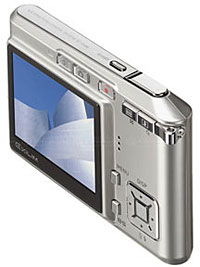 CASIO have announced their new, wafer-thin EXILIM CARD EX-S600 digital camera.
CASIO have announced their new, wafer-thin EXILIM CARD EX-S600 digital camera. According to Casio’s announcement, Revive Shot mode “adjusts for obliquity as well as brightly refreshes faded colours.”
According to Casio’s announcement, Revive Shot mode “adjusts for obliquity as well as brightly refreshes faded colours.” As is de rigeur on consumer compacts, there’s a built in movie mode with the Casio capturing MPEG-4, VGA (640×480 pixels) at 30 frames/second.
As is de rigeur on consumer compacts, there’s a built in movie mode with the Casio capturing MPEG-4, VGA (640×480 pixels) at 30 frames/second. Macrovision, a company who sell content protection (DRM) system, have today released a report they commissioned into content copying.
Macrovision, a company who sell content protection (DRM) system, have today released a report they commissioned into content copying. This is on the basis of what to us appears, from a quick once over of this report, a pretty unscientific approach, as the following paragraph from page 10 illustrates.
This is on the basis of what to us appears, from a quick once over of this report, a pretty unscientific approach, as the following paragraph from page 10 illustrates. I hope that each time a ‘report’ or so called research like this is published, that it is gone through with a fine tooth comb pointing out its weaknesses. This kind of nonsense needs to be countered.
I hope that each time a ‘report’ or so called research like this is published, that it is gone through with a fine tooth comb pointing out its weaknesses. This kind of nonsense needs to be countered. Canon are trumpeting that they are “bringing IXUS style and performance to the wireless age” with the release of their PowerShot camera.
Canon are trumpeting that they are “bringing IXUS style and performance to the wireless age” with the release of their PowerShot camera. The camera can be registered with up to 8 target devices including wireless access points via a secure communication system to prevent eavesdropping or interception of your photographic masterpieces.
The camera can be registered with up to 8 target devices including wireless access points via a secure communication system to prevent eavesdropping or interception of your photographic masterpieces. Although we naturally warm to the convenience and sheer ‘techiness’ of Wi-Fi enabled digital cameras, we remain to be convinced that the technology has reached maturity yet.
Although we naturally warm to the convenience and sheer ‘techiness’ of Wi-Fi enabled digital cameras, we remain to be convinced that the technology has reached maturity yet. We speak from some experience here too, after foolishly being seduced by Sony’s innovative – but frankly pointless – Bluetooth feature on its 20002 DSC FX77 camera.
We speak from some experience here too, after foolishly being seduced by Sony’s innovative – but frankly pointless – Bluetooth feature on its 20002 DSC FX77 camera. More details about Jason Tomczak’s class action against Apple for releasing defective iPod Nanos have emerged on The Inquirer’s site.
More details about Jason Tomczak’s class action against Apple for releasing defective iPod Nanos have emerged on The Inquirer’s site.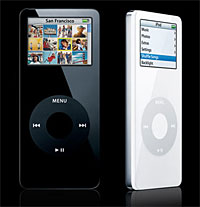 The plaintiff alleges that with Steve Jobs whipping the Nano out of his pocket in a TV advert, Apple led consumers to believe the machine was durable.
The plaintiff alleges that with Steve Jobs whipping the Nano out of his pocket in a TV advert, Apple led consumers to believe the machine was durable.  Ironically, things haven’t been helped by the iPod nano appearing on the scene straight after the phone’s launch, with the ultra-small pocket rocket holding 10 times the amount of songs for half the price
Ironically, things haven’t been helped by the iPod nano appearing on the scene straight after the phone’s launch, with the ultra-small pocket rocket holding 10 times the amount of songs for half the price